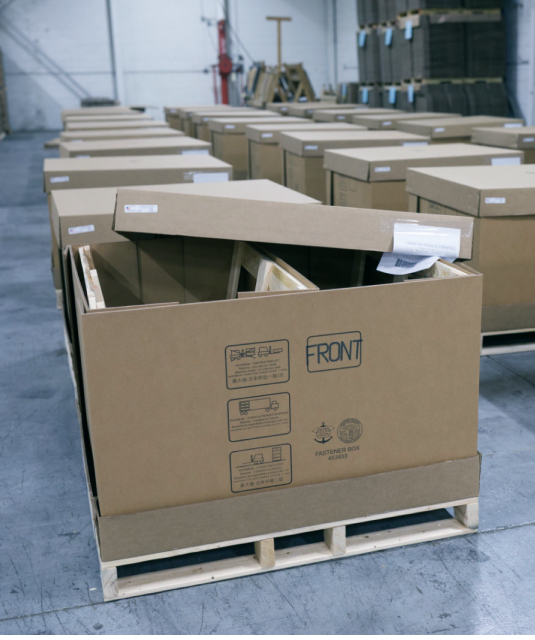



Quality in packaging for parts and products is crucial because it ensures protection during transportation and storage.
Products and parts can be delicate and complex, and they must be packaged with utmost care to avoid damage, scratches, or contamination.
If the packaging does not meet standards, it can result in costly product recalls, delays in production, or even safety hazards if parts are damaged.
Quality packaging also helps reduce waste and promote sustainability. Therefore, manufacturers must prioritize quality in packaging to ensure it provides optimal.


We closely monitor materials and the manufacturing process with quality inspectors at every location. Proactively seeking out quality issues allows timely corrective action and ensures our products are manufactured to meet customer requirements and regulatory standards.


The material inspection process begins with the receipt of raw materials from suppliers.
We then perform visual and physical inspections to check for any signs of damage, defects, or discrepancies. We test materials to ensure they meet specifications for strength, durability, and other quality parameters. Where necessary, we also perform additional tests, such as chemical analysis, to verify the material’s composition and properties.
If the material passes the inspection, it is released for use in the manufacturing process. However, if any issues are identified, the material is rejected or sent back to the supplier for corrective action.
This level of quality control helps ABP maintain consistent quality across all products and provides customers with reliable and high-quality packaging solutions.
ISO 9001:2015 certification demonstrates ABP’s commitment to maintaining consistent and reliable quality management systems throughout its organization. ISO 9001:2015 ensures our products meet customer requirements and comply with applicable regulatory standards.
ISTA certification ensures ABP’s packaging products have been tested and certified to withstand various shipping conditions and protect the package’s contents.
Ecovadis certification ensures ABP follows sustainable practices and meets environmental and social responsibility criteria. ABP focuses on using sustainable materials, reducing waste, and minimizing the environmental impact of its operations.
Good packaging has several qualities that make it effective in protecting and promoting the product it contains; these include:
A packaging manufacturer can improve the quality of its product in five specific ways.
ISO 9001 certified manufacturing refers to implementing a quality management system (QMS) that meets the requirements of the ISO 9001 international standard. This standard outlines the necessary components of a QMS, including quality policy, quality objectives, documented procedures, and continuous improvement processes.
ISO 9001 certification is a third-party verification that a manufacturing company has implemented a QMS that meets the standard’s requirements. This certification demonstrates the company’s commitment to quality and its ability to provide products that meet customer requirements and regulatory standards consistently.
ISTA certification means that a packaging company has successfully tested its products to meet the International Safe Transit Association (ISTA) requirements. ISTA is an industry association that develops standards and protocols for packaging testing and certification. The certification ensures that the packaging can withstand various transportation and handling conditions and adequately protect the product it contains.
To achieve ISTA certification, a packaging company must conduct rigorous tests on its packaging products The tests simulate real-world transportation and handling conditions, such as drops, vibrations, and impacts. The packaging is then evaluated for any signs of damage or other issues that could affect the product’s safety or performance. If the packaging passes the tests and meets the ISTA standards, the packaging company is awarded certification.
For customers, ISTA certification provides assurance the packaging will adequately protect the product during transportation and storage, reducing the risk of damage or other issues.
Ecovadis is a global provider of sustainability ratings and assessments of companies. The organization evaluates companies based on their environmental, social, and ethical performance. The assessment process includes a detailed review of the company’s policies, procedures, and practices related to sustainability, and a review of the company’s supply chain.
Ecovadis certification is recognized globally as a standard for sustainability performance. Companies that achieve Ecovadis certification demonstrates commitment to sustainable practices and social responsibility.
HT certification stands for Heat Treatment and is a certification that indicates that lumber has been treated to prevent the spread of pests and diseases. This treatment involves heating the lumber to a specific temperature for a specified period to kill any insects or larvae that may be present in the wood. This treatment is often required for the international shipping of lumber products.
ITSPM certification stands for International Tropical Timber Organization – Program for the Endorsement of Forest Certification. The certification indicates that the lumber has been sourced from a responsibly managed forest. The certification process includes assessing the forest management practices, including environmental and social criteria.
Together, these certifications indicate that the lumber has been responsibly sourced and treated to prevent the spread of pests and diseases, which assures customers that the product meets certain quality and sustainability standards.